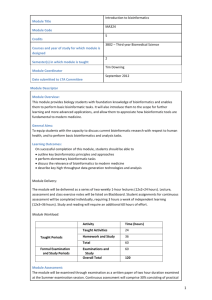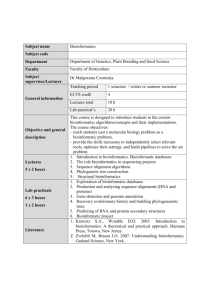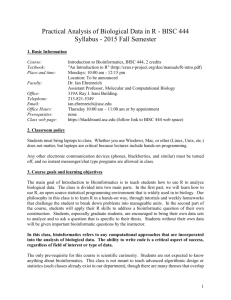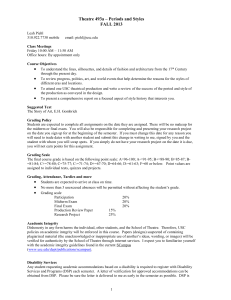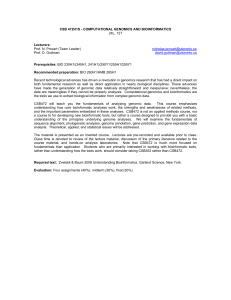BME302L - Syllabus - University of Southern California
advertisement
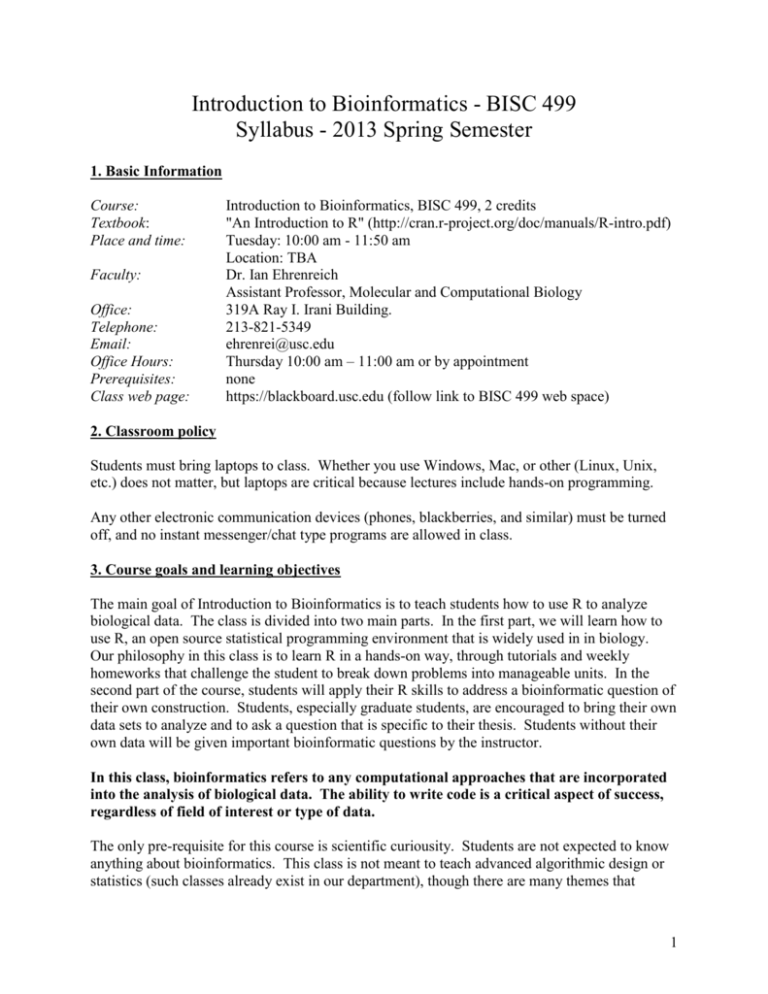
Introduction to Bioinformatics - BISC 499 Syllabus - 2013 Spring Semester 1. Basic Information Course: Textbook: Place and time: Faculty: Office: Telephone: Email: Office Hours: Prerequisites: Class web page: Introduction to Bioinformatics, BISC 499, 2 credits "An Introduction to R" (http://cran.r-project.org/doc/manuals/R-intro.pdf) Tuesday: 10:00 am - 11:50 am Location: TBA Dr. Ian Ehrenreich Assistant Professor, Molecular and Computational Biology 319A Ray I. Irani Building. 213-821-5349 ehrenrei@usc.edu Thursday 10:00 am – 11:00 am or by appointment none https://blackboard.usc.edu (follow link to BISC 499 web space) 2. Classroom policy Students must bring laptops to class. Whether you use Windows, Mac, or other (Linux, Unix, etc.) does not matter, but laptops are critical because lectures include hands-on programming. Any other electronic communication devices (phones, blackberries, and similar) must be turned off, and no instant messenger/chat type programs are allowed in class. 3. Course goals and learning objectives The main goal of Introduction to Bioinformatics is to teach students how to use R to analyze biological data. The class is divided into two main parts. In the first part, we will learn how to use R, an open source statistical programming environment that is widely used in in biology. Our philosophy in this class is to learn R in a hands-on way, through tutorials and weekly homeworks that challenge the student to break down problems into manageable units. In the second part of the course, students will apply their R skills to address a bioinformatic question of their own construction. Students, especially graduate students, are encouraged to bring their own data sets to analyze and to ask a question that is specific to their thesis. Students without their own data will be given important bioinformatic questions by the instructor. In this class, bioinformatics refers to any computational approaches that are incorporated into the analysis of biological data. The ability to write code is a critical aspect of success, regardless of field of interest or type of data. The only pre-requisite for this course is scientific curiousity. Students are not expected to know anything about bioinformatics. This class is not meant to teach advanced algorithmic design or statistics (such classes already exist in our department), though there are many themes that 1 overlap with those fields. The emphasis in this course is on practical implementation, not on computational aesthetics. Specifically, we will learn: How to manipulate large datasets using read, write, and comparative functions. How to create customized statistical tests using simulations. Real biological data often violate critical assumptions of standard statistical tests. The more sophisticated biologist knows how to account for complexities of the data through permutation and randomization. How to construct a pipeline of different programs that automates genomic analysis. Most importantly, this class will provide students the means to break down a scientific hypothesis into its fundamental elements, a necessary prerequisite to coding for the answers. 4. Course plan and weekly readings To maximize the benefit of attending class, you must read the selected pages listed below before coming to class. Week Textbook pages 5 6 7 8 9 Topic Installing R; Basic usage, packages, & I/O Basic elements & syntax Arrays, matrices, & data frames Conditional indexing & subsetting Loops & apply() statements Writing your own functions Simple plots Classes Midterm 10 Standard statistical tests Ch. 8, 11 11 Randomization: Permutation, Bootstrapping, & Jackknifing 12 Simulating data 13 Complex plots 14 15 16 Final presentations Final presentations Final presentations 1 2 3 4 Ch. 1, 7, 13 Ch. 2, 3, 4 Ch. 5, 6 Ch. 5, 6 Ch. 9, 10 Ch. 10 Ch. 12 Ch. 13, 14 Ch. 8 Weeks 1-13: These initial weeks will be spent learning R from the ground up, in a hands-on way. After 13 weeks, students will be fluent in Python. We will then apply our newly gained knowledge to address a specific scientific question. Students (especially graduate students) are 2 encouraged to bring their own data and their specific question to class for this purpose. Otherwise, genomics level problems will be assigned to them. Weeks 14-16: The last three weeks of the course will be dedicated to student presentations, where students go from hypothesis, to data analysis, to conclusions using computational approaches. 6. Professor Dr. Ian Ehrenreich ehrenrei@usc.edu 213-821-5349 319A Ray R. Irani Building 1050 Childs Way University of Southern California Los Angeles, CA 90089 Dr. Ehrenreich maintains an active research program focused on studying the genetic basis of complex traits, as well as how microbes interact with their hosts and each other. Bioinformatics represents an integral part of these endeavors. 7. Required material Textbook: "An Introduction to R" (http://cran.r-project.org/doc/manuals/R-intro.pdf) Additional online materials will be specified throughout the course Laptop computer (if you do not have one, we can provide one for you) 8. Assessment Grades are based on four scores: 1) midterm grade, which tests fluency with R, 2) weekly homework assignments where students solve bioinformatic challenges by writing code, 3) the code written for their bioinformatics project, which must work and must be properly annotated, and 4) final presentations, a 20 minute talk including slides where the student describes their own bioinformatic project, the code that solves their particular problem, and draws valid biological conclusions: Assessment Procedure Midterm Weekly homeworks Final project code Final project presentation Percent 25% 25% 25% 25% 8.1. Criteria for grading: The midterm will be a closed book test that consists of both written questions and answers as well as computer programming problems. Bioinformatics code will be graded according to proper annotation of code and ability to solve the problem of interest. The final presentation will be graded according to clarity of scientific hypothesis, appropriateness of 3 data to address that hypothesis, ability of the student to effectively communicate their bioinformatic strategy, and on the substance of their conclusions. Students who are not able to meet deadlines due to medical or other emergency must notify the instructor or unofficial TA immediately. 8.2. Course grade: The course is not curved. Letter grades will follow a straight scale: 90% and above leading to A, 80-90% leading to B, etc. Pluses and minuses are assigned by dividing each range in corresponding halves (A, A-) or thirds (B+, B, B-, C+, ...). 9. Policy against Cheating All USC students are responsible for reading and following the Student Conduct Code, which appears in the Scampus and at http://www.usc.edu/dept/publications/SCAMPUS/goverance. This policy does not apply to discussion or exchange of ideas. On the contrary, such interactions represent an important way to clear programming hurdles. Statement for Students with Disabilities Any student requesting academic accommodations based on a disability is required to register with Disability Services and Programs (DSP) each semester. A letter of verification for approved accommodations can be obtained from DSP. Please be sure the letter is delivered to me (or to TA) as early in the semester as possible. DSP is located in STU 301 and is open 8:30 a.m.–5:00 p.m., Monday through Friday. The phone number for DSP is (213) 740-0776. Statement on Academic Integrity USC seeks to maintain an optimal learning environment. General principles of academic honesty include the concept of respect for the intellectual property of others, the expectation that individual work will be submitted unless otherwise allowed by an instructor, and the obligations both to protect one’s own academic work from misuse by others as well as to avoid using another’s work as one’s own. All students are expected to understand and abide by these principles. Scampus, the Student Guidebook, contains the Student Conduct Code in Section 11.00, while the recommended sanctions are located in Appendix A: http://www.usc.edu/dept/publications/SCAMPUS/gov/. Students will be referred to the Office of Student Judicial Affairs and Community Standards for further review, should there be any suspicion of academic dishonesty. The Review process can be found at: http://www.usc.edu/student-affairs/SJACS/.. 11. Resources 11.1. Web page: A class website will be setup on Backboard containing information about the course: syllabus, laboratory handouts, grades, miscellaneous information about weekly class activities, and an email directory of all people in the class. Use it as much as you find it useful. The web page can be accessed through the main stem https://Blackboard.usc.edu. 11.2 Office Hours: Office hours will be held weekly. Time and location for my office hours are at the beginning of the syllabus. Those of the unofficial teaching assistant will be decided with 4 you in class. Both of us are available by email to help you as much as you need. During weeks 10-13, every student will meet with me at least once outside of class so that progress on projects can be assessed and any obstacles encountered solved. 5
